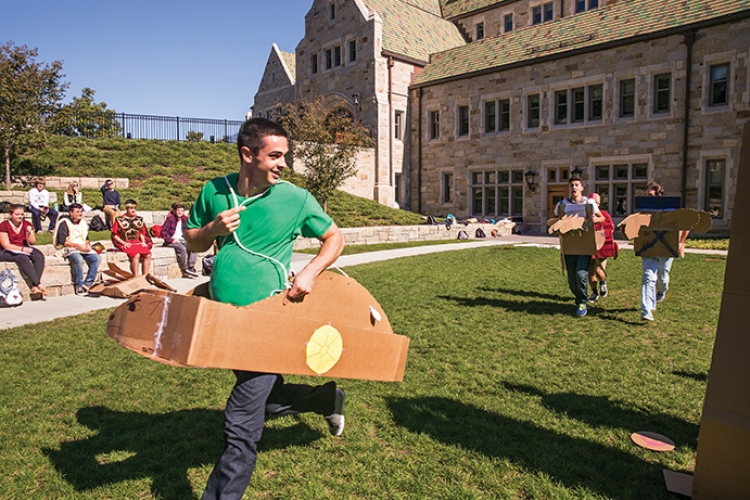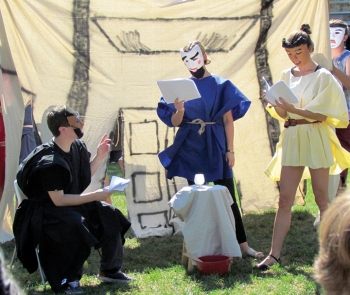
By
The Stokes Hall amphitheater is a popular campus spot for al fresco studying, socializing, snacking, and occasionally, for a musical or theatrical performance. Earlier this month, the amphitheater was the venue for something a little different: a chariot race.
Well, sort of. The “chariots” were actually cardboard boxes that were worn, rather than ridden, by the competitors, who – instead of horses – used their own feet to propel themselves around the “track.”
But this wasn’t some spur-of-the-moment activity concocted by students at loose ends: It was a project for the Roman Spectacles undergraduate class taught by Assistant Professor of Classical Studies Christopher Polt.
Polt’s course examines Ancient Rome’s penchant for public spectacles – theatrical shows, gladiatorial combats, military parades, animal hunts, funeral processions, even ritual sacrifices and Christian martyrdoms, as well as chariot races – and the role such events played in Roman society and culture.
While Roman spectacles have been a staple in popular media over the years – from “Ben Hur” to “Star Trek” to Monty Python – Polt says his course seeks a deeper understanding of such events, from a perspective less focused on Rome’s political, social or artistic elites, and more from the viewpoint of everyday citizens.

“What I want students to pay attention to is, who produced these spectacles, and why?” he explains. “What benefits did they get from doing so, whether real or intangible? How did the spectators respond to and participate in the events? And most of all, how did these spectacles reinforce or challenge the social norms and traditional values – for individuals and for society at large?”
Such questions, Polt adds, are equally relevant in considering latter-day versions of spectacles, like the Super Bowl or blockbuster movies.
“The culture of Ancient Rome was different from ours, obviously, but the manner in which spectacles promote common values and beliefs is similar in many respects. And there was a lot of concern voiced back then about the arena or the circus as ‘a debauched place’ that would foster immorality. So the conversation about violence or other negative aspects in popular entertainment that we’re having today is not a new one; they had it centuries ago.”
Rather than rely on lectures or readings, Polt has his Roman Spectacles students immerse themselves into the subject matter. Earlier this semester, he assigned the class to adapt and stage scenes from a comedy, “Curculio,” by Plautus. Besides fashioning costumes, scenery and props – however minimalist – students also had to make masks, which actors in Ancient Rome typically wore during performances, Polt notes: This necessitated them to rely more on voice, gestures, movements and body language to effectively communicate emotions and nuances.
“I wanted the students to have a sense of what went into these productions by putting themselves in there, to be thoughtful and make decisions about how to meet the criteria.”
Similarly, Polt had the students assume specific roles and tasks associated with staging an Ancient Rome-style chariot race. In addition to the four contestants, the event featured two race officials; a herald who served as the Ancient Rome equivalent of a public address announcer; and – perhaps most importantly – the sponsor for the event. The remaining students were the spectators, whose loyalties were divided among, and represented by, the respective colors of the four racers: red, blue, white and green.
The event began with a procession of the contestants, officials and sponsor, and included what might be called “half-time entertainment” between the heats: a marching exhibition, and an animal hunt -– in this case a teddy bear conveyed by one of the race officials (the teddy bear met its doom in less than five minutes).
The sponsor’s role fell to freshman Gerardo Martinez Cordeiro, who had to plan the event’s itinerary, provide food and programs for the spectators, build the chariot for his team’s contestant, and even construct an obelix (like the chariots, it was made of cardboard) as the centerpiece of the race track.
But, as Cordeiro explains, he also had to assume the mien of a generous sponsor. “I was the guy who sat in the middle of the stands and at the very front so those in attendance —those enjoying my sponsorship — could see me. This was a display of wealth, power and generosity and I had to present that.”
Cordeiro found no shortage of modern-day parallels on which to model his character: “Politicians in rallies and galas, and in the way they display their love for the people; celebrities and professional athletes who throw parties or charitable events, especially when open to the public; private and public corporations when they sponsor sports tournaments or have other athletic competitions like the Olympics, the World Cup, or March Madness.
“We pretty much see this in any person or entity who is willing to spend the time, effort and resources to provide some sort of entertainment for the people – whatever the ulterior motives may be.”
The students also staged a military parade and reenacted a wedding this month.
Max de la Rosa, a junior history major who played the herald to Cordeiro’s sponsor (“I tried to convey the best qualities and nobleness of my ‘employer’”), has greatly enjoyed Polt’s class. “I am of the opinion that we can always learn from the past. I am continuously surprised how similar Roman and American cultures are to each other – how extravagant, lavish, and at times gaudy each can be, for example. We might not watch murder happen before our eyes like in Ancient Rome’s gladiatorial battles, but our athletes are no less than what gladiators were in Rome.
“This similarity between the ancient world and our world is absolutely fascinating to me.”



